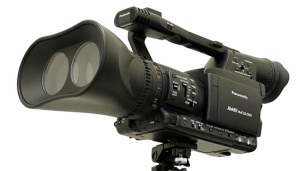 Soon you won’t need to be James Cameron to make your very own 3D movie.
Soon you won’t need to be James Cameron to make your very own 3D movie.
Most 3D video is shot using expensive equipment and processing software only big movie studios can afford. It’s getting cheaper quickly, though. Last month, LG unveiled its high-end Optimus phone, the first with a glasses-free 3D display and a pair of cameras, allowing video to be captured in 3D.
According to Dunacan Graham-Rowe, a simpler device is being developed in China that will allow regular cellphones to capture and process 3D photos and videos. The prototype, developed by Wallen Mphepo at the Beijing Normal University, takes the form of an attachment that fits over the lens of a mobile phone camera.
The device has two apertures, corresponding to the fields of view for the viewer’s left and right eyes. Light from each one is guided towards the camera’s lens using two pairs of mirrors. On the way, each beam passes through a filter, one red and the other cyan. A device called a splicer breaks the image from each aperture into slices, which it combines in an alternating pattern. The result is a complete stereoscopic image captured by a single lens with the left and right images interlaced into every other column of the camera’s light sensor.
Normally complex image-processing software is needed to carry out the equivalent tasks. “This way the hardware does all the work,” Mphepo says. He presented his work at the Society for Information Display conference in Jugenheim, Germany this month. Using a singe frame to store both views halves the resolution of the image, but the result ca be viewed on all form of 3D screens with or without glasses, and with no need for further processing, Mphepo says.
“It’s a legitimate feature to add to a phone,” says Douglas Lanman of the Massachusetts Institute of Technology. Many devices have a such a high resolution that losing some through a splicer shouldn’t be noticeable, he says. Whether or not cellphone manufacturers adopt something like Mphepos rig will probably depend on whether it can be miniaturized, Lanman says. “Volume is everything in a portable device.”
Mphepo agrees, adding that while the prototype is small enough to be attached to a phone, the ultimate aim will be to integrate the technology into the phone itself. “We’re talking to manufacturers in Beijing to see how it can be embedded in cellphones.”
# # #
bloomfield knoble creates marketing plans, strategy, creative design, collateral, Power Point presentations, email templates, videos, audio, music videos, television commercials, letterhead, identity, gift cards, SWOT analyses, brochures, letter templates, software applications, web applications, multimedia productions, Flash content, streaming videos, logo designs, widgets, technical consulting.
